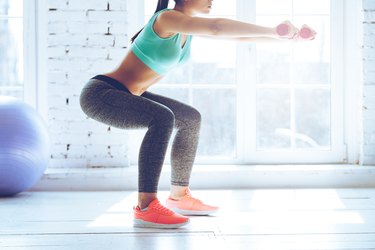
You cannot avoid activating your hip flexors in the squat — if your hip flexors do not activate, you cannot move up and down. You can, however, increase the activation of your gluteus maximus in the squat by modifying your stance. The depth of your squat also determines the activation of your gluteus maximus, according to a study published in The Journal of Strength and Conditioning Research. Squatting below a 90-degree angle works your glutes harder.
Read More: What Muscles Do Squats Target?
Video of the Day
Video of the Day
Modifying Your Stance
Stand with your feet wider than your shoulders. Experiment with a stance that allows you to stand with your feet at least half-again as wide as your shoulders. Turn your toes out slightly to accommodate your stance. A wider stance shifts the work slightly to your posterior chain, which includes your hamstrings and your gluteus maximus, according to research in Medicine & Science in Sports & Exercise.

Doing a Squat
Step 1
If you're ready to use a weight — you should get used to the movement first — hold a barbell firmly on your upper back, but below the level of the top of your shoulders. Do not carry the bar on your neck.
Step 2
Squat down by pushing your hips back, not down, until your thighs are parallel with the floor. This will force the glutes to activate to stop the downward momentum. Stand up by pushing back against the bar with your shoulders before straightening your legs.
Step 3
Squat in the same manner, but squat down to a sturdy box or platform that will not collapse under the weight of your squat. This allows you some security when pushing your hips back. Pause briefly on the box before standing up. This forces the muscles of your hips to work harder to drive you up off of the box, instead of relying on the elastic reflex of your muscles.
Read More: 12 Essential Squat Variations to Try
Warning
Only do a squat that goes farther than 90 degrees if you have healthy knees. Start without any resistance, and work your way up to using weight.